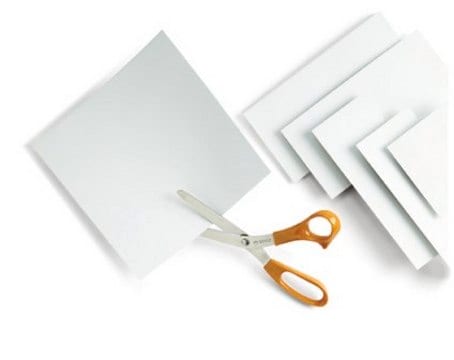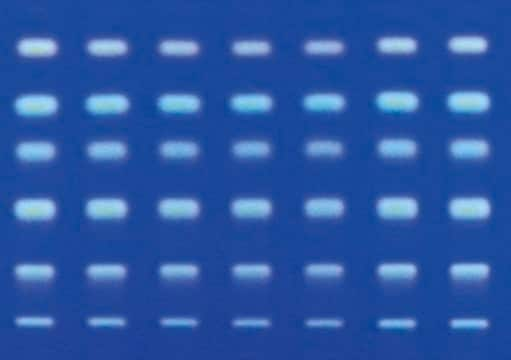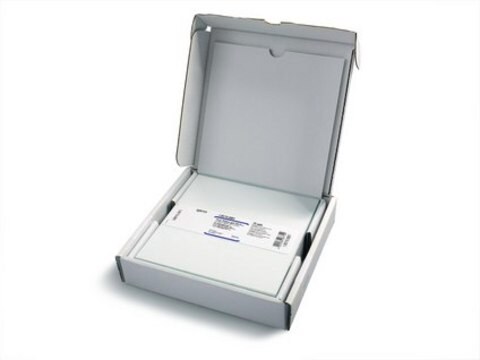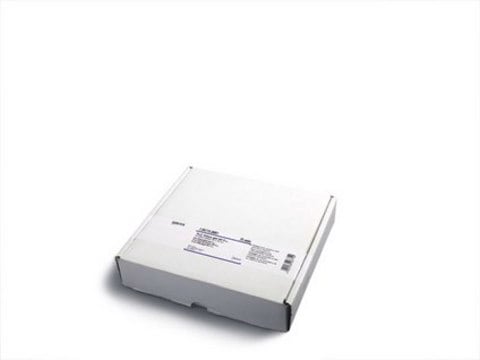추천 제품
material
glass support
silica gel 60 matrix
Quality Level
특징
binder Organic Polymer
fluorescent indicator: no
포장
pkg of 25 plates
기술
thin layer chromatography (TLC): suitable
레이어 두께
200 μm
플레이트 길이 × 너비
20 cm × 10 cm
입자 크기
5-6 μm
공극 크기
60 Å medium pore diameter
저장 온도
2-30°C
일반 설명
25 Glass plates 20 x 10 cm
RP modified plates serve two purposes: act as a pilot method for HPLC and allow to choose various solvent system for special separations. Our RP-modified silica layers are well suited for many separation challenges that unmodified silica cannot overcome. These layers use aqueous solvent systems to separate extremely non-polar substances and analyze particular polar substances that can adapt to ion-pair chromatography. What’s more, RP-modified silica layers are less dependent on atmospheric humidity. Unlike unmodified silica, RP-phases do not exhibit catalytic activity. This makes them the plates of choice for unstable substance that tend to experience oxidative degradation.
애플리케이션
- Densitometric HPTLC method for qualitative, quantitative analysis and stability study of Coenzyme Q10 in pharmaceutical formulations utilizing normal and reversed-phase silica gel plates.: This study presents a high-performance thin-layer chromatography (HPTLC) method for analyzing Coenzyme Q10 in pharmaceutical formulations. The method employs both normal and reversed-phase silica gel plates to achieve qualitative and quantitative analysis, as well as stability testing of Coenzyme Q10 (Abdel-Kader et al., 2016).
- Simultaneous Quantification of Gymnemic Acid as Gymnemagenin and Charantin as β-Sitosterol Using Validated HPTLC Densitometric Method.: This research develops a validated HPTLC densitometric method for the simultaneous quantification of gymnemic acid and charantin in herbal formulations. The method utilizes silica gel 60 F₂₅₄ plates for effective separation and quantification (Ahamad et al., 2015).
- Estimation of catechin in Ayurvedic oil formulations containing Acacia catechu.: The study estimates the content of catechin in Ayurvedic oil formulations using HPTLC. Silica gel 60 F₂₅₄ plates are employed to ensure accurate quantification of catechin in these formulations (Dubey et al., 2009).
- Development and validation of HPTLC method for estimation of tacrolimus in formulations.: This paper details the development and validation of an HPTLC method for estimating tacrolimus in pharmaceutical formulations. The method uses silica gel 60 F₂₅₄ plates for efficient separation and quantification of tacrolimus (Borhade et al., 2009).
- Estimation of berberine in ayurvedic formulations containing Berberis aristata.: The research focuses on the estimation of berberine in Ayurvedic formulations. Using HPTLC with silica gel 60 F₂₅₄ plates, the study provides a reliable method for berberine quantification (Rout et al., 2008).
결합
Replaces: 5914-6; 5914
분석 메모
Specific surface area (according to BET; 5-Pt. measurement): 480 - 540 m²/g
Pore volume (N₂-isotherm): 0.74 - 0.84 ml/g
d 50 (laser diffraction, size distribution): 5 - 7 µm
Layer thickness: 150 - 200 µm
Deviation of layer thickness per plate: ≤ 35 µm
Chromatographic testings:
A) Cholesterin test
hRf-values
- cholesterin, cholesterin test:
13 - 23
B) Steroid test
- methyltestosterone, steroid test: 20 - 35
- Reichstein S, steroid test: 50 - 65
- hydrocortisone, steroid test: 65 - 80
Typical value determined on an activated plate (120°C, 15 min)
Eluent a) aceton/ water (95/5 v/v)
Eluent b) acetonitrile/ water (70/30 v/v)
Pore volume (N₂-isotherm): 0.74 - 0.84 ml/g
d 50 (laser diffraction, size distribution): 5 - 7 µm
Layer thickness: 150 - 200 µm
Deviation of layer thickness per plate: ≤ 35 µm
Chromatographic testings:
A) Cholesterin test
hRf-values
- cholesterin, cholesterin test:
13 - 23
B) Steroid test
- methyltestosterone, steroid test: 20 - 35
- Reichstein S, steroid test: 50 - 65
- hydrocortisone, steroid test: 65 - 80
Typical value determined on an activated plate (120°C, 15 min)
Eluent a) aceton/ water (95/5 v/v)
Eluent b) acetonitrile/ water (70/30 v/v)
시험 성적서(COA)
제품의 로트/배치 번호를 입력하여 시험 성적서(COA)을 검색하십시오. 로트 및 배치 번호는 제품 라벨에 있는 ‘로트’ 또는 ‘배치’라는 용어 뒤에서 찾을 수 있습니다.
이미 열람한 고객
자사의 과학자팀은 생명 과학, 재료 과학, 화학 합성, 크로마토그래피, 분석 및 기타 많은 영역을 포함한 모든 과학 분야에 경험이 있습니다..
고객지원팀으로 연락바랍니다.




